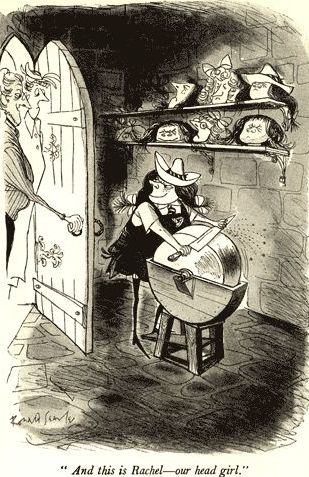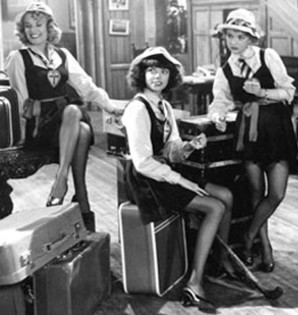It’s the start of another term for the gin-making, thieving, violent girls of St. Trinians. Head mistress Millicent Fritton (Alastair Sim in one of the great drag performances) is mainly concerned with how to get enough cash for the school to remain open, and bets the school’s money on a race horse owned by a sultan who’s just sent his young daughter to school there. Her mob-connected brother Clarence (also Sim) is concerned with using his 6th form daughter to pick up racing information from the princes. The local police want to shut it all down, and send Sgt. Ruby Gates (Joyce Grenfell) undercover to join the unqualified teaching staff. This sets up a conflict between Miss Fritton, the spiv Flash Harry (George Cole), the staff, and the 4th form girls who want the sultan’s horse to run and win, and Clarence, the mob, and the 6th form girls, who want to stop it, with Superintendent Kemp Bird (Lloyd Lamble) and the agent for the Ministry of Education (Richard Wattis) stuck in the middle.
 Ronald Searle created the world of St. Trinian’s in a series of one frame cartoons. Think of it as if Charles Addams had focused on boarding school girls. He drew the first few before he became a POW during WWII. The cartoons took a darker and funnier turn after the war, often filled with the smiling young girls and their deceased victims. Searle and his girls became extremely popular.
Ronald Searle created the world of St. Trinian’s in a series of one frame cartoons. Think of it as if Charles Addams had focused on boarding school girls. He drew the first few before he became a POW during WWII. The cartoons took a darker and funnier turn after the war, often filled with the smiling young girls and their deceased victims. Searle and his girls became extremely popular.
The producing/writing/directing team of Sidney Gilliat and Frank Launder had made a name for themselves with their script for Hitchcock’s The Lady Vanishes (1938), and its semi-sequel, Night Train to Munich (1940), and went on to create one of the best films of 1946, the Foscar nominated I see a Dark Stranger. Launder was an expert with farce while Gilliat’s greatest skill lay with harsh satire. Both were known for their ability to bring characters to life and their skills meshed well. They dove into the Post-War British Comedy movement with The Happiest Days of Your Life (1950), a boarding school comedy starring Alastair Sim and Margaret Rutherford, with support from Richard Wattis, Guy Middleton, and Joyce Grenfell, and with opening titles animated by Ronald Searle. It was a success and so when it came time for a follow-up, they didn’t have to go far: St. Trinian’s. They added frequent co-writer Val Valentine, kept Launder in the director’s chair, and decided to keep most of the cast, adding Sim’s protégé, George Cole. The comedy would be much broader, as fit the material. And then a misfortune turned lucky; Rutherford was unavailable, so they double-cast Sim, having him play his own sister. Rutherford is always wonderful, but no one could have surpassed Sim’s performance. It is the stuff of pure comic genius.
The cartoons had no story, so one had to be invented. The script cleverly follows Miss Fritton, Clarence, and Sgt. Gates instead of the school girls. The girls never could be real and if they were front and center, you couldn’t ignore that half of them should be dead and the others arrested for murder in our world. Instead the girls are the foundation, forever present, but behind our main players. The fun comes not only from the girls making gin, setting off explosives, stealing horses, torturing other girls, and being a mix between adorable and fiends from hell, but from how everyone responds to them. It’s the fear of them that makes them so hilarious, or in a few cases, the nonchalant way characters treat the mayhem. It’s the drinking and drug-taking that the authorities indulge in to calm their nerves whenever the school is mentioned that makes it all work. A small child banging on nitroglycerin is amusing; Miss Fritton calmly advising her to be careful with the explosive is what puts it over the top.
 Another marvelous invention is the 6th form girls. The cartoons just had little monsters. The film adds older girls—too old to be in school, which is one of the jokes. “Pogo” (and yes, you are supposed to think about how she got that nickname) is married. “Not officially,” chimes in Miss Fritton, but you get the point. These elder girls are just as evil, but less random. They scheme and plan and add seduction to their armory, and are the basis for the St. Trinian’s Girl fetish in Britain, where the idea of the sexy Catholic school girl was replaced. And this allows for an additional type of humor in the film, perhaps tame by current standards, but risqué for 1954.
Another marvelous invention is the 6th form girls. The cartoons just had little monsters. The film adds older girls—too old to be in school, which is one of the jokes. “Pogo” (and yes, you are supposed to think about how she got that nickname) is married. “Not officially,” chimes in Miss Fritton, but you get the point. These elder girls are just as evil, but less random. They scheme and plan and add seduction to their armory, and are the basis for the St. Trinian’s Girl fetish in Britain, where the idea of the sexy Catholic school girl was replaced. And this allows for an additional type of humor in the film, perhaps tame by current standards, but risqué for 1954.
Launder’s direction is nimble, but not showy, keeping the jokes coming, and allowing his cast of most of the best England had to offer to shine. The Belles of St. Trinian’s is a near perfect comedy. It’s hard to gauge its legacy, but the still-present St. Trinian’s cosplay parties show that this film may no longer sit at the front of British culture, but it has made its mark.
It was followed by a series of progressively weaker sequels made by Launder and Gilliat: Blue Murder at St. Trinian’s (1957), The Pure Hell of St. Trinian’s (1960), The Great St. Trinian’s Train Robbery (1966), and The Wildcats of St. Trinian’s (1980). It was rebooted as a girl-power film in 2007 with the simple title of St. Trinian’s, which got it’s own sequel, St Trinian’s 2: The Legend of Fritton’s Gold, two years later.
Alastair Sim is perhaps best known for Scrooge (1951). In addition to this film, he appeared in 11 films in the Post-War British Comedy movement: Hue and Cry (1947), The Happiest Days of Your Life (1950), Laughter in Paradise (1951), Lady Godiva Rides Again (1951), Folly to Be Wise (1952), Innocents in Paris (1953), Escapade (1955), Wee Geordie (1955), The Green Man (1956), Blue Murder at St. Trinian’s (1957), Left Right and Centre (1959), School for Scoundrels (1960).
The list of other Post-War British Comedies directed, produced or written by Launder and/or Gilliat mainly repeats the sequel and Sim lists, but to be complete: The Happiest Days of Your Life (1950), Lady Godiva Rides Again (1951), Folly to Be Wise (1952), Wee Geordie (1955), The Green Man (1956), Blue Murder at St. Trinian’s (1957), Left Right and Centre (1959), The Bridal Path (1959), The Pure Hell of St. Trinian’s (1960), The Great St. Trinian’s Train Robbery (1966), The Wildcats of St. Trinian’s (1980).
